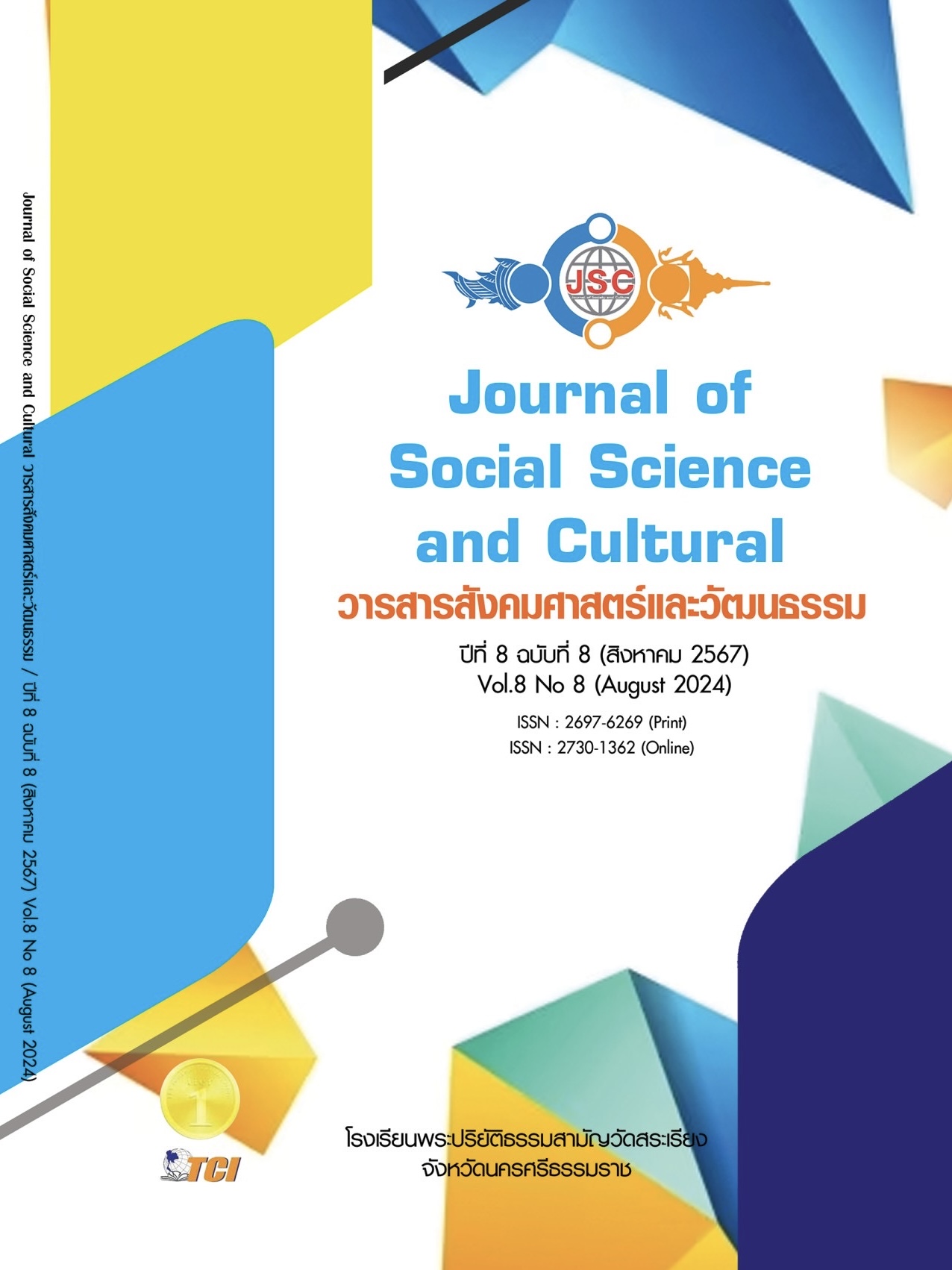GUIDLINES TO PREPARING FOR THE REGISTRATION OF THE HALA-BALA FOREST AS A WORLD HERITAGE SITE BY INVOLVING COMMUNITY PARTICIPATION PROCESSES
Main Article Content
Abstract
This research aimed to 1) gather data to develop a community-participatory area management plan towards the preparation for the registration of the Hala-Bala Forest as a world heritage site, and 2) create awareness within the community to advocate for the Hala-Bala Forest as a world heritage site. It was a participatory qualitative research that selected key informants based on recommendations from stakeholders in the area, including local leaders (3 people), community members (6 people), and representatives from governmental and non-governmental organizations (2 people), totaling 11 individuals, along with 40 participants in community forums. Data collection methods included document analysis, interviews, focus group discussions, and community forums. Data were analyzed using the triangulation method to compare findings, classify, and organize the information, followed by interpretative analysis to generate narrative summaries. The research findings suggested that: 1. Collaborative strategies and participation from all sectors are essential for preparing the Hala-Bala Forest for world heritage registration, emphasizing community participation processes to ensure collective benefits from the forest; and 2. Community awareness for advocating the Hala-Bala Forest as a world heritage site can be achieved through: 1) enhancing understanding and building resilient communities, 2) promoting cooperation and community responsibility through collaborative initiatives, 3) fostering confidence and endorsement, and 4) promoting community leadership.
Article Details
References
กระทรวงการต่างประเทศ. (2566). อนุสัญญาว่าด้วยการคุ้มครองมรดกโลกทางวัฒนธรรมและธรรมชาติ (WHC). เรียกใช้เมื่อ 17 มีนาคม 2566 จาก https://fad.mnre.go.th/th/mph/content/219
ประพจน์ ณ บางช้าง และคณะ. (2564). การพัฒนานวัตกรรมีการสื่อสารแบบมี่ส่วนร่วมีของชุมชนเพื่อส่งเสริมการท่องเที่่ยวเชิงสร้างสรรค์อย่างยั่งยืนของจังหวัดระนอง. วารสารนิเทศศาสตรปริทัศน์, 25(3),156-167.
ผู้ให้สัมภาษณ์คนที่ 1. (15 ธันวาคม 2565). บทสัมภาษณ์เกี่ยวกับการขึ้นทะเบียนป่าฮาลา-บาลาเป็นมรดกโลก. (คมวิทย์ สุขเสนีย์, ผู้สัมภาษณ์)
ผู้ให้สัมภาษณ์คนที่ 2. (15 ธันวาคม 2565). บทสัมภาษณ์เกี่ยวกับการขึ้นทะเบียนป่าฮาลา-บาลาเป็นมรดกโลก. (นินุสรา มินทราศักดิ์, ผู้สัมภาษณ์)
ผู้ให้สัมภาษณ์คนที่ 3. (15 ธันวาคม 2565). บทสัมภาษณ์เกี่ยวกับการขึ้นทะเบียนป่าฮาลา-บาลาเป็นมรดกโลก. (ภูตรา อาแล, ผู้สัมภาษณ์)
ผู้ให้สัมภาษณ์คนที่ 5. (15 ธันวาคม 2565). บทสัมภาษณ์เกี่ยวกับการขึ้นทะเบียนป่าฮาลา-บาลาเป็นมรดกโลก. (ฐานกุล กุฏิภักดี, ผู้สัมภาษณ์)
ผู้ให้สัมภาษณ์คนที่ 6. (15 ธันวาคม 2565). บทสัมภาษณ์เกี่ยวกับการขึ้นทะเบียนป่าฮาลา-บาลาเป็นมรดกโลก. (คมวิทย์ สุขเสนีย์, ผู้สัมภาษณ์)
ผู้ให้สัมภาษณ์คนที่ 7. (15 ธันวาคม 2565). บทสัมภาษณ์เกี่ยวกับการขึ้นทะเบียนป่าฮาลา-บาลาเป็นมรดกโลก. (นาเดีย ปายอ, ผู้สัมภาษณ์)
ภัทรานิษฐ์ ศุภกิจโกศล และคณะ. (2554). การมีส่วนร่วมของชุมชนในการบริหารจัดการแหล่งมรดกโลก: กรณีศึกษา: อุทยานประวัติศาสตร์พระนครศรีอยุธยา และอุทยานประวัติศาสตร์สุโขทัย - ศรีสัชนาลัย - กำแพงเพชร. ใน รายงานการวิจัย. มหาวิทยาลัยราชภัฏสวนดุสิต.
สมศักดิ์ สามัคคีธรรม. (2558). ชุมชน ความเป็นส่วนตัว และการพัฒนาในยุคโลกาภิวัตน์. วารสารพัฒนาสังคมและยุทธศาสตร์การบริหาร, 17(1), 1-27.
สมศักดิ์ สามัคคีธรรม. (2566). การเสริมพลังชุมชนกับการพัฒนาที่ยั่งยืน. กรุงเทพมหานคร: สถาบันบัณฑิตพัฒนบริหารศาสตร์.
สำนักงานบริหารและพัฒนาองค์ความรู้. (2564). รู้จัก 6 มรดกโลกของไทย. เรียกใช้เมื่อ 20 พฤษภาคม 2564 จาก https://www.okmd.or.th/okmd-kratooktomkit/4717/
Smith, J. (2020). Exploring the biodiversity of Halabala Forest. Journal of Tropical Ecology, 15(3), 45-58.
UNESCO. (2020). World Heritage List. Retrieved November 20, 2020, from https://whc.unesco.org/en/list/


